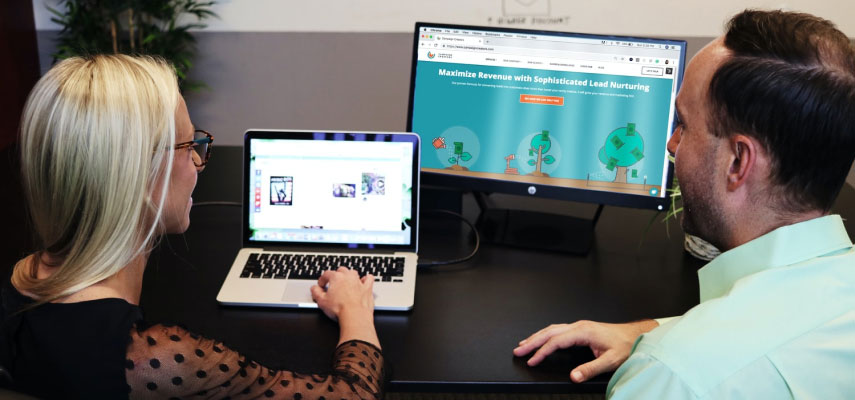First Touch Resolution
You want your customers to be happy with your product or service. Happy customers, after all, tend to come back. There’s no single metric to track that satisfaction, but one comes close: first touch resolution.
Let’s be honest. When many customers think about customer care, they don’t necessarily get happy feelings. Instead, they think about being passed around, on hold, or from channel to channel, eventually hanging up frustrated because nothing’s changed.
The good news is that it doesn’t have to be that way. You just have to focus on the right metrics.
First Contact Resolution: A Definition

The term, in many ways, is self-explanatory: first contact resolution measures your customer care department’s ability to resolve a problem the first time a customer contacts them.
We’re talking about a true resolution here. A frustrated customer no longer demanding answers, but clearly unsatisfied, does not count in favor of this metric. Only true solved problems, with no follow-up required, are measured as successful.
You typically see this KPI as a percentage, as in: XX% of our calls get resolved at first contact. You might also see it referred to as first touch resolution, first call resolution, and other similar terms.
3 Reasons First Touch Resolution Should Be a Core KPI

With a basic definition out of the way, let’s dig a little more into the benefits of tracking this KPI. Both in isolation and in combination with other metrics like average call time, it matters for a number of reasons:
1. Increase Your Customer Satisfaction

Naturally, an emphasis on and improvement of first call resolution increases your number of satisfied customers. The faster you can get your audience the answers they need, solving their problems in the process, the happier they’ll be (and the more your long-term revenue will increase).
In fact, according to one study, every percentage point increase in this metric also resulted in a corresponding 1% increase in customer satisfaction. Another study found an improvement in customer satisfaction of between 40% and 70% that correlated directly with significant first touch resolution increases.
Solid data backing up a common-sense conclusion? Definitely something to pay attention to.
2. Increase Your Employee Satisfaction

It’s not quite as obvious as customer satisfaction, but still important to highlight: your employees also benefit from higher resolution percentages.
The reason is simple. As a result of prioritizing this concept, your employees will receive better training and become more empowered to help customers. They’ll be less likely to face frustrated conversation partners in the process, leading to increased job satisfaction.
On an even more basic level, faster resolutions will lead to less congested call and chat queues. Customer service agents will need to juggle fewer conversations, allowing them to focus on the ones that matter and become better at solving problems.
3. Better Streamline Your Customer Service

Lastly, but certainly not least importantly, an emphasis on first-call resolution allows you to streamline your entire customer service operations. Many of the steps explained below help not just this metric, but the entire process.
By tracking first call resolution, you begin to understand what areas require more training, and where service calls tend to fall through. You also understand how your service channels may influence the types of questions in need of being resolved.
And then, of course, there’s the increased efficiency mentioned above. More streamlined processes lead to a more efficient, and ultimately more profitable operation that benefits both your organization and your external stakeholders.
6 Steps to Optimize Your First Touch Resolution

Understanding that you have to prioritize this KPI is a crucial first step. But of course, it’s only the beginning. Making the actual improvements is at least as, if not more important.
Fortunately, it’s actually quite straightforward. Each of the below steps should be a part of your customer service efforts, to begin with; prioritizing it will only improve your operations as a whole. So let’s dig in.
1. Make it a Priority Across Your Customer Service Efforts

It starts as straightforward. As your first step, make sure that everyone in your organization who is even tangentially involved in customer service understands both the concept and its importance.
That naturally include frontline employees, who are actually talking to and interacting with your customers. But don’t stop there. Talk to sales managers, supervisors, and even your executives about it.
The goal here is to make first call resolution a part of your customer service culture. Ideally, everyone even indirectly involved with customer interactions should have it in their DNA, almost inevitably trying to accomplish it.
The more people understand this metric and its importance, the more easily you’ll be able to both prioritize and track it over time.
2. Understand Channel Nuances for Common Problems

We’ve talked in-depth about the need for omnichannel interactions as a core customer-service tenet. Modern audiences expect an answer quickly in their channel of choice, and they expect you to respond to their individual needs rather than adjusting to yours.
When it comes to first contact resolution, the need goes even deeper than that. Someone who reaches out to you on social media might typically ask a different question, or ask the same question differently, than the same customer picking up the phone.
Generally speaking, modern audiences use social media for very specific complaints they want others to see. They use live chat for general answers, and phone calls for more personal issues that might include their private information.
And of course, they’ll ask these questions differently, as well. A phone call might result in a long explanation, while a tweet is condensed into 280 characters or fewer.
For your first call resolution efforts, that means one thing: don’t treat every channel the same. Instead, make a conscious effort to analyze each of your customer service channels and how your audiences interact on them.
Through that analysis, you can better understand exactly what your audiences expect, making you more likely to respond to them in a way that satisfies their needs. That’s how you get that satisfaction percentage up, no escalation needed.
3. Understand the Reasons for Follow-ups and Redirects

The analysis doesn’t stop there. It’s time to dig deeper into the reasons your audience might not be satisfied after a single call or contact with your company.
That starts by seeking feedback from your employees. Learn why they’ve had to escalate issues in the past, or when they’ve had to leave a customer unsatisfied. Their insights can be invaluable, thanks to lots of practical, frontline experience.
With the right tracking in place, you can also perform a root cause analysis. Identify customers who have been in touch with you more than once, and dig into why they might have called back or sent you another message. Then, go back into the initial conversations and see if any part of the interaction there might have caused this problem.
Finally, talk to supervisors who might receive calls or contacts escalated to them by frontline employees. Have they noticed themes of the types of problems raised to them? Are there simple steps you could take to minimize these issues?
The more comprehensive your analysis, the better. Ideally, after this analysis, you’ll have a good idea of the most common reasons behind calls that couldn’t be resolved at first touch.
4. Ensure Proper Factual Training for Frontline Employees

With a proper understanding of both channel nuances and reasons for dissatisfaction, it’s time to start the training process. Prioritizing training resources, in fact, is the most important piece of making sure your employees can help your customers.
Factual or skills training is an important part of that equation. Make sure they know everything they need to about your company and its products, including common troubleshooting issues. That means not just providing active training, but also giving them plenty of time to read up on user manuals etc., and improving their knowledge base as a result.
This training, done right, can empower your frontline employees. You no longer have to provide them with specific scripts to follow, but can rely on the fact that they’ll have enough expertise to guide your customers.
5. Emphasize the Soft Skills in Your Agent Training

Just as importantly, of course, is your ability to provide frontline employees the soft skill training and development they need to succeed. Communication skills, for instance, matter just as much as just ‘knowing their stuff’.
In fact, their ability to empathize with their audience is absolutely critical. Teach them active listening skills, the ability to understand a problem at its core and ask the right follow-up questions to get there.
It also includes the ability to de-escalate a call if a customer starts to become frustrated. And of course, the simple ability to double-check if the answer they’re given actually helps the customer can go a long way towards providing the solution.
When it comes to customer service, your employees need to be knowledgeable and friendly, but also avoid fluff and learn how to get straight to the point. This is not when your customers are at their most patient. They need someone who can help them quickly.
Finally, soft skills training should include sessions that help your employees avoid asking for a call-back or contact through a different channel. This goes back to the first step above: the first and most important goal should always be to get the issue resolved right then, and right there.
6. Track Performance to Build Continuous Improvement Mechanisms

Last but not least, the best way to optimize your first touch resolution metric is to integrate it directly into your analytics and customer service improvement KPIs. It’s a complex process, because this is not necessarily an easy metric to track. But a few steps can help:
- Start by setting specific goals, based on typical resolution percentages within your industry.
- Define exactly how you’ll track first contact resolution. How do you define resolution, and how can you currently track it in your calls?
- Measure your current percentage, and how it compares to your goals and those resolution percentages.
- Closely monitor your first call resolution on a weekly basis. If it improves, can you point to a reason why? If it’s going down, what might be the reason?
Getting to that point, of course, requires what we emphasized in the first step: a true prioritization of the metric across your organization. Everyone needs to be on board with tracking and improving it. But once that happens, building a strategy based on improving your first touch resolution is actually quite straightforward.
Ready to Build a Better Customer Experience?

Ultimately, it’s all about building a better customer experience. With first contact resolution, you can get there. That’s why the steps above allow you to hit the sweet spot in making sure your customer service efforts are as streamlined as possible, raising customer satisfaction and reducing bottlenecks in the process.
To get there, you might need help. Actually, you most definitely do. Unless you have a smoothly running omnichannel customer service procedure set up, complete with expansive training and comprehensive analytics and reporting processes, it will seem daunting.
The good news is that it doesn’t have to be. With the right contact center partner, you can streamline the process and minimize potential hiccups as you work towards one touch resolution.
That partner needs to embrace the metrics as much as you do, and have both the agents and tracking mechanism on board to turn priority into reality. That’s what we specialize in, so let’s talk through the process. We might just be perfect for each other in optimizing your customer (and employee) satisfaction through this core KPI.